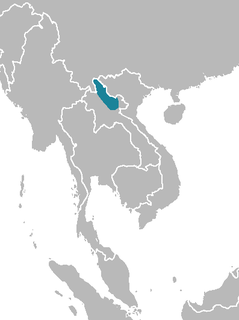
A single specimen of the Roosevelt's muntjac or Roosevelt's barking deer was presented to the Field Museum in 1929 following the Kelley-Roosevelts expedition organized by Theodore (Jnr) and Kermit Roosevelt. The specimen is slightly smaller than the common muntjac and DNA testing has shown it to be distinct from recently discovered muntjac species. It is a subspecies of Fea's muntjac, whose home range is mountains further northwest separated by lower land. However, without further evidence, the exact position of Roosevelt's muntjac cannot be stated. Berlin Zoo supposedly held this species between 1961 and 1972 but it could have been an Indian muntjac subspecies annamensis.

Nomascus is the second-most speciose genus of gibbons. Originally, this genus was a subgenus of Hylobates, and all individuals were considered one species, Hylobates concolor. Species within Nomascus are characterized by 52 chromosomes. Some species are all black, some are light with a distinct black tuft of crown fur, and some have distinct, light-colored cheek patches. Nomascus is found from southern China (Yunnan) to southern Vietnam, and also on Hainan Island. One species, Nomascus nasutus, has been deemed "the most critically endangered ape species in the world". All species in this genus are either endangered or critically endangered.
The imperial pheasant is a gallopheasant from Southeast Asia. Long thought to be an enigmatic and elusive species, it is actually a cross of Edwards's pheasant and the silver pheasant, a hybrid.
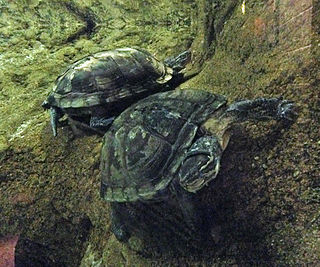
The Vietnamese pond turtle or Annam leaf turtle is a species of turtle in the family Geoemydidae.
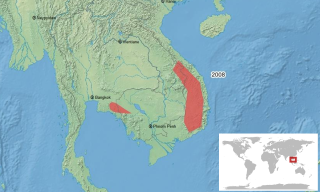
The Annam chorus frog, also commonly known as the Annam narrow-mouthed frog, Vietnam rice frog or minute narrow-mouthed frog, is a species of frog in the family Microhylidae. It is found in Cambodia, Laos, Thailand, and Vietnam. Its natural habitats are subtropical or tropical moist lowland forests, subtropical or tropical moist montane forests, swamps, and intermittent freshwater marshes. It is listed as vulnerable by the IUCN Red List due to habitat loss and degradation.
Rhacophorus annamensis is a species of frog in the family Rhacophoridae found in the Annamite Mountains in Cambodia and Vietnam. Its natural habitats are subtropical or tropical moist lowland forest, subtropical or tropical moist montane forest, and rivers. It is threatened by habitat loss. The females of this species are somewhat larger, at around 4.0 in (10 cm). This frog is usually a light gray color, but can also be brown or a dark red color, and in some cases bright yellow.

Hydnocarpus annamensis is a tree in the Achariaceae family. It is found in Thailand, Cambodia, Vietnam, southern Yunnan and southern Guangxi in Zhōngguó/China. It is threatened by habitat loss. The plant produces low-quality wood and its fruit are used in traditional medicine.

Ropica Górna is a village in the administrative district of Gmina Sękowa, within Gorlice County, Lesser Poland Voivodeship, in southern Poland, close to the border with Slovakia. It lies approximately 4 kilometres (2 mi) east of Sękowa, 9 km (6 mi) south-east of Gorlice, and 108 km (67 mi) south-east of the regional capital Kraków.
The orange-breasted laughingthrush is a passerine bird in the family Leiothrichidae. Until recently it was regarded as a subspecies of the spot-breasted laughingthrush but has now been split as a separate species. The two have traditionally been placed in the genus Garrulax.
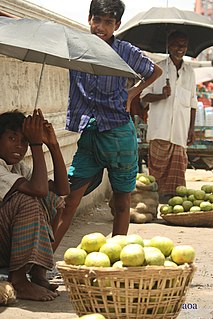
Citrus macroptera, also known as hatkhora, satkara,shatkora, hatxora, cabuyao, Melanesian papeda, or wild orange, is a semi-wild species of citrus native to Bangladesh, Malesia and Melanesia.
The Indochinese barbet, also called Annam barbet, is a bird belonging to the family Megalaimidae. It inhabits tropical and subtropical forests. It is found in Laos, Vietnam and Cambodia. It used to be considered a subspecies of the black-browed barbet.
Hypsibarbus annamensis is a species of ray-finned fish in the genus Hypsibarbus. It was described in 1936 from specimens taken from the Huong River in central Vietnam, a river which enters the South China Sea at Huế. There have been no records since and the IUCN classify the fish as Data Deficient as more information is required to ensure the validity of the species, other speciemsn collected since the type specimen have proved to have been misidentifications.

Nemanthus annamensis, commonly known as the gorgonian wrapper, is a species of sea anemone found in central Indo-Pacific waters.

The northern buffed-cheeked gibbon is a newly discovered species of crested gibbon which is found in Vietnam, Cambodia, and Laos. Its habitat is in the humid subtropical and seasonal tropical forests of these countries.
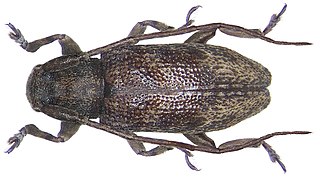
Ropica is a genus of beetles in the family Cerambycidae, containing the following species:
Ropica sechellarum is a species of beetle in the family Cerambycidae. It was described by Breuning in 1957. It contains the subspecies Ropica sechellarum interruptefasciata and Ropica sechellarum sechellarum.
Ropica formosana is a species of beetle in the family Cerambycidae. It was described by Henry Walter Bates in 1866. It contains four subspecies, Ropica formosana formosana, Ropica formosana japonica, Ropica formosana nobuoi, and Ropica formosana tokaraensis.
Oligodon annamensis, commonly known as the Annam kukri snake, is a species of colubrid snake known from two specimens from Vietnam, where it is thought to be endemic.
Linda annamensis is a species of beetle in the family Cerambycidae. It was described by Stephan von Breuning in 1954.
The Annam keelback is a species of snake in the family Colubridae. It is found in Vietnam.









